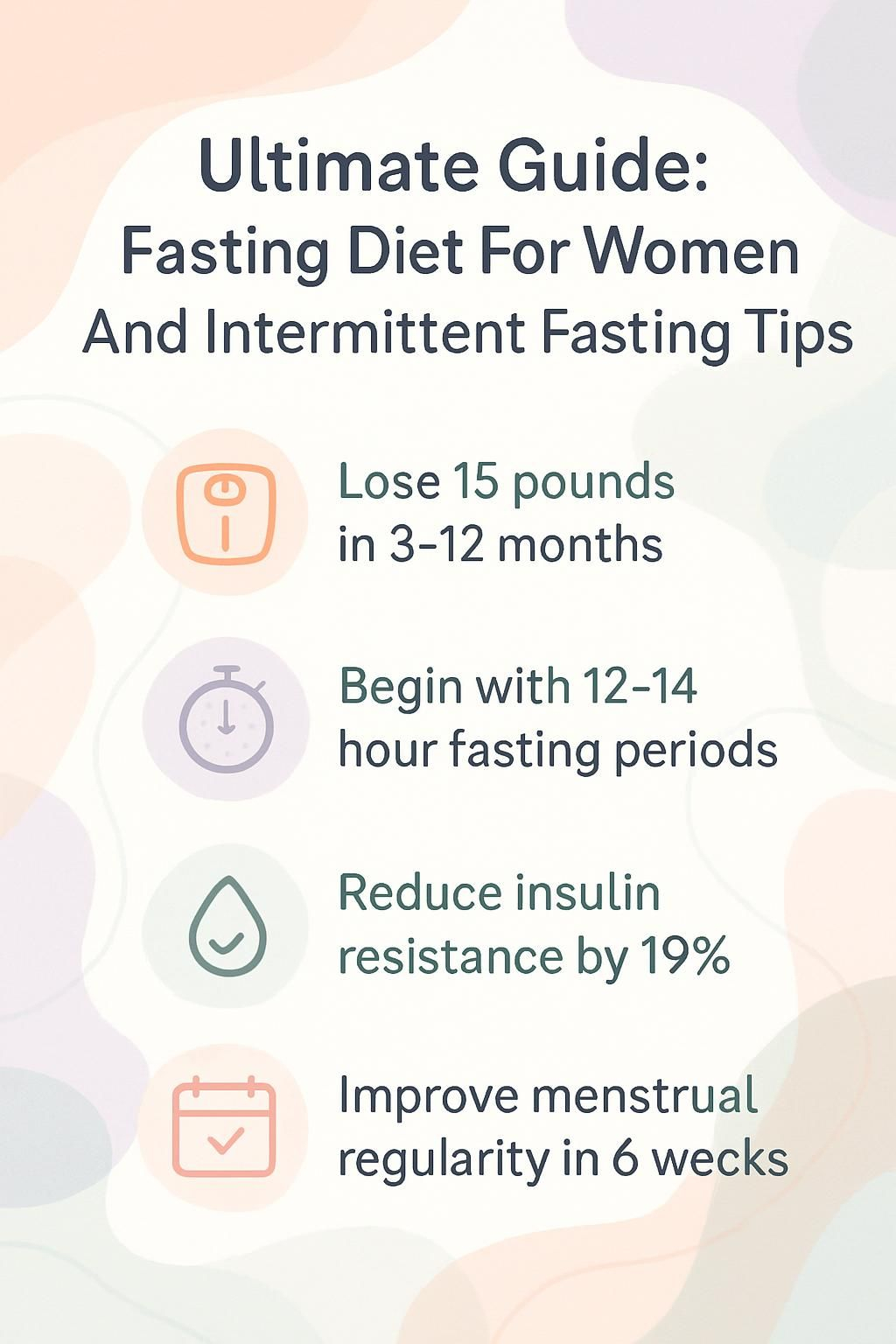Ultimate Guide: Fasting Diet For Women And Intermittent Fasting Tips
Our Nutrition Assistant AI Suite will transform your body. You will lose fat, get toned, and build muscle. Gain confidence and optimal health.
Stuck after trying diet after diet with little change? Intermittent fasting shifts the focus from what you eat to when you eat. Many women use this fasting diet to manage body weight, improve energy, and support health.
This guide gives step-by-step advice, practical tips, and data you can trust. You will learn how different fasting schedules work, how they affect hormones, and how to start safely. Small shifts in meal timing can bring steady results.
Key Takeaways
- Popular types of intermittent fasting, like 16/8 or 5:2, can help women lose about 15 pounds on average within 3 to 12 months, based on a randomized controlled trial in 2011.
- Start with shorter fasts, 12 to 14 hours. Longer fasts can disrupt hormones and lead to irregular periods for women in their reproductive years, as noted in peer-reviewed research from 2005.
- Intermittent fasting may reduce insulin resistance by 19 percent, lower insulin by 29 percent, and improve cholesterol by up to 25 percent within 6 months in several studies from 2009 to 2011.
- Women with PCOS who used an 8-hour eating window for six weeks saw improved menstrual regularity and lower body fat in 2021 research.
- Avoid intermittent fasting if you are pregnant, breastfeeding, under 18, have type 1 diabetes, or have a history of eating disorders.

What Is Intermittent Fasting?

Intermittent fasting is an eating plan that cycles between fasting and eating periods. Research suggests it can support weight management and metabolic health.
What does intermittent fasting mean?
Intermittent fasting sets specific times for meals and gaps without food. You focus on meal timing rather than counting every calorie. The 16/8 method asks you to fast for 16 hours and eat within an 8-hour window each day.
The 5:2 approach keeps regular eating five days a week, then limits calories to about 500 to 600 on two non-consecutive days. During fasts, water, black coffee, and plain tea are typically fine since they have almost no calories.
Many people find less snacking and fewer late-night meals with this eating pattern. That change often leads to natural calorie control without strict tracking.
My first week of intermittent fasting meant delaying breakfast until noon. Cravings dropped at night, and my blood sugar level felt steadier through the afternoon.
Intermittent fasting focuses more on meal timing than strict calorie counting.
Some plans alternate fasting every other day. Others keep a daily time-restricted pattern. Choose the option that fits your routine, then stay consistent.
Next, see how fasting shifts your metabolism during the fasted and fed states.
How does intermittent fasting affect the body?
After about 12 hours without food, the body starts using stored fat for fuel. This switch, called metabolic flexibility, can bring hunger or irritability in the first two to four weeks. Headaches, constipation, or low energy can appear during the early adjustment.
Studies show fasting can lower fasting glucose, insulin, and leptin, a hormone that signals fullness. Some people see better insulin sensitivity, which helps with blood sugar control.
Compared to constant calorie cuts, intermittent fasting may preserve more lean muscle while reducing fat. Blood pressure and resting heart rate often improve, which supports heart health.
After three weeks on a steady schedule, I noticed fewer cravings and more consistent energy. Hormones play a large role here, especially for women, which we cover next.
Intermittent Fasting and Women’s Unique Needs
Intermittent fasting can affect women and men differently due to hormone patterns. Knowing these differences helps you plan safely.
How do hormones affect intermittent fasting in women?
Calorie restriction can influence reproductive hormones in women. Fasting may reduce signals like GnRH, LH, and FSH, which guide ovulation and menstrual cycles.
When these hormones shift, cycles can become irregular or even pause. One study from 2005 reported worsened blood sugar control in women after several weeks of fasting, while men did not show the same response.
Lower estrogen from chronic restriction may also affect bone health over time. Many experts advise shorter fasting windows and fewer fasting days per week for women. Talk with your physician before making major changes.
Understanding how fasting can influence your cycle and fertility will help you protect long-term health.
What is the impact on menstrual cycles and reproductive health?
Intermittent fasting can change menstrual patterns. In a 2021 study, women aged 18 to 31 with PCOS who used an 8-hour eating window for six weeks reported more regular cycles and reduced body fat. If you have PCOS, a cautious time-restricted plan may help.
Some women develop irregular periods when fasting is long or strict. Those trying to conceive, or with a history of missed periods, should avoid aggressive fasting plans. People with past eating disorders or nutrient gaps face higher risks.
Shorter fasts or fewer fasting days can reduce stress on hormones while still offering benefits.
Next are the most popular types of intermittent fasting plans you might want to try.
Popular Types of Intermittent Fasting Plans
Several plans help with weight loss and metabolic health. Each method sets a fasting window and an eating window, which can change your results and comfort level.
What is the 16/8 method?
The 16/8 method uses a daily 16-hour fast and an 8-hour eating window. For example, you may eat from noon to 8 p.m., then fast overnight until noon.
Some women start with 14 hours, then move to 16 once they adjust. In a small study, women over 60 who used a 16/8 plan for six weeks lost about 2 kilograms, or 4.5 pounds. Time-restricted eating may also help preserve muscle compared to constant calorie cuts.
People using a shorter 4-hour window in another study ate about 650 fewer calories per day. Many women see modest drops in body weight and waist size with this plan.
How does the 5:2 method work?
The 5:2 plan keeps five normal eating days and two low-calorie days each week. Pick two non-consecutive days, such as Monday and Thursday. On those days, aim for 500 to 600 total calories, split into small meals.
This approach offers flexibility while still creating meaningful calorie restriction. In a 2011 randomized controlled trial with overweight women, fasting schedules similar to 5:2 reduced insulin by 29 percent and insulin resistance by 19 percent in six months. Cholesterol measures improved in related studies.
Many find this method easier than daily restriction. The rest-day rhythm can make long-term adherence more realistic.
What is alternate-day fasting?
Alternate-day fasting means fasting every other day. On fasting days, some people have only water, while others use a small meal that provides about 20 to 25 percent of usual calories, around 500 calories for many adults.
This pattern extends the fasting state and may speed fat loss. Studies report average weight loss around 15 pounds over 3 to 12 months in adults with overweight. Research also suggests better insulin sensitivity over time.
Hunger, mood shifts, and headaches are common on fasting days. Planning simple meals and drinking enough water can help. This method is not safe for teens, pregnant or breastfeeding women, or anyone with a history of eating disorders.
This schedule can affect women differently because of hormones, so proceed with care.
What is time-restricted eating?
Time-restricted eating sets a daily eating window, usually 6 to 8 hours, with fasting for the remaining 16 to 18 hours. For example, eat between noon and 8 p.m., then avoid calories until the next day.
Start with 12 or 14 hours of fasting, then expand as you adapt. In women with PCOS, an 8-hour window for six weeks improved menstrual regularity and reduced body fat.
This method is flexible and easier to maintain than more rigid schedules. Many women prefer it for long-term health benefits.
Health Benefits of Intermittent Fasting for Women
Intermittent fasting has been shown to support weight loss, improve blood sugar control, lower inflammation, and help heart health. Think of it as a daily reset for your metabolism.
How does intermittent fasting help with weight loss and fat reduction?
Fasting creates a natural calorie gap and encourages your body to use stored fat for fuel. Across studies, overweight adults lost about 15 pounds in 3 to 12 months. Waist sizes also dropped, sometimes by a meaningful margin within several weeks.
Time-restricted plans can help maintain muscle while reducing fat. In older women using 16/8 for six weeks, average weight loss was around 2 kilograms. These steady shifts add up over time.
From my experience, a consistent eating window cut my snacking and made clothes fit better within two months. Results depend on your food choices and total calories during eating windows.
For best progress, focus on protein, fiber, and whole foods to feel full and protect muscle.
Can intermittent fasting improve heart health?
Intermittent fasting may lower several heart risk markers. A 2009 clinical study reported reductions within eight weeks: blood pressure down about 6 percent, LDL cholesterol down about 25 percent, and triglycerides down about 32 percent.
These changes can reduce risk for cardiovascular disease. Resting heart rate and inflammation may also improve. Benefits are strongest while the plan is in place. If old habits return, gains can fade.
My blood pressure dropped several points after four weeks on a steady schedule. More long-term studies in women are needed, but early data is encouraging.
How does intermittent fasting regulate blood sugar and reduce diabetes risk?
Structured fasting can improve insulin function. In a 2011 randomized trial with overweight or obese women, insulin levels fell by 29 percent and insulin resistance by 19 percent over six months.
Some people with type 2 diabetes reduce medication needs under medical supervision, though this should be done with a clinician. Short-term fasting often matches classic calorie restriction for blood sugar control.
If you have type 1 diabetes, or risk hypoglycemia, do not fast without medical guidance. Always consult your healthcare professional before changing your eating plan if you have a chronic condition.
What is the effect on inflammation?
Better blood sugar control links to lower inflammation. Research shows fasting can reduce markers like C-reactive protein, which is tied to heart disease, arthritis, and some cancers.
Animal studies also suggest less tissue damage after surgery with fasting. Lower inflammation may support brain health and mood stability as you age. More long-term studies are underway.
How does intermittent fasting enhance brain health and focus?
Fasting triggers metabolic changes that may help the brain. A 2019 review in the New England Journal of Medicine, led by Mark Mattson, linked fasting to better cognitive health and longevity.
Increased brain-derived neurotrophic factor supports learning and memory. Some adults report sharper focus with time-restricted plans, which may reflect lower inflammation and steadier blood sugar.
Many women, myself included, notice clearer thinking and more stable moods after several weeks on a consistent schedule.
How to Start an Intermittent Fasting Diet
Start small and build slowly. A few careful steps protect energy and hormonal balance while you learn what works for your body.
Should you begin with shorter fasting periods?
Yes. Begin with 12 to 14 hours, especially if you are new to fasting. Shorter fasts reduce headaches, irritability, and low energy that can happen in the first few weeks.
A crescendo approach works well for many women. Fast 12 to 16 hours on two or three non-consecutive days, then adjust based on how you feel. Long fasts right away can stress the body and may disrupt your cycle.
When I started, shorter fasts felt manageable and kept my energy steady. Personalizing your plan makes success more likely.
Next, see why hydration can make or break your fasting day.
How important is hydration during fasting?
Hydration is essential. Water, black coffee, and plain tea are allowed during fasts. They can ease headaches, bad breath, and low energy that sometimes occur.
Fluids support digestion and fat metabolism. Adequate water also reduces constipation, a common issue with longer gaps between meals.
During eating windows, include hydrating foods like fruits and vegetables. Low-sodium broths can help as well.
What are nutrient-dense meals to eat during eating windows?
Build meals with the Mediterranean pattern in mind. Combine leafy greens, lean protein such as chicken or salmon, healthy fats from olive oil or avocado, and complex carbs like quinoa or whole grain bread.
Pair protein and fiber to stay full longer. Healthy fats support hormone balance, which is vital for women. Fill half your plate with colorful vegetables to cover key vitamins and minerals.
Limit sugary and ultra-processed foods. They spike insulin and can undermine the health benefits you are working toward.
What Foods Should Women Eat During Intermittent Fasting?
Food choices matter. The right mix supports gut health, mood, energy, and steady progress with weight goals.
What are good high-protein options?
Lean proteins like chicken breast, turkey, and fish fit well. Greek yogurt and cottage cheese add quality protein and calcium. One large egg gives about 6 grams of protein, which helps control hunger.
Plant options include lentils, black beans, chickpeas, tofu, and edamame. A half-cup of cooked lentils has about 9 grams of protein. Mix beans with quinoa for more protein and fiber.
Aim to include a protein source at every meal to protect muscle. I added grilled salmon at lunch and noticed steadier energy for workouts.
Healthy fats and complex carbs round out a balanced plate.
Which healthy fats and complex carbs are best?
Choose unsaturated fats such as olive oil, avocado, almonds, walnuts, chia seeds, and flaxseed. These support hormone health and help you feel satisfied.
Pick complex, unrefined carbs for steady energy. Whole grains like brown rice and quinoa, and starchy vegetables like sweet potatoes, offer fiber and key nutrients. They keep blood sugar more stable than refined grains.
What hydrating foods and beverages are recommended?
During eating windows, include cucumbers, leafy greens, oranges, and watermelon. Soups and low-sodium broths add fluids and electrolytes.
Drink water throughout the day. During fasts, herbal tea and black coffee provide zero-calorie options. Skip sugary drinks, which can disturb metabolic balance.
Safety and Risks of Intermittent Fasting for Women
Fasting affects people differently, and women often need extra care because of hormonal and reproductive health. Safety comes first.
Who should avoid intermittent fasting?
Teens under 18 should avoid fasting due to growth needs. Pregnant and breastfeeding women should not fast because higher calorie and nutrient intake is required for mother and baby.
People with type 1 diabetes using insulin face dangerous low blood sugar during fasts. Anyone with a history of eating disorders, underweight status, or nutrient deficiencies should not start intermittent fasting without medical supervision.
Women with amenorrhea or fertility concerns need medical guidance. If your medication requires food at set times, speak with your doctor before changing your schedule.
When I tried alternate-day fasting, I felt dizzy and irritable on restricted days. That was my cue to stop and reassess with professional advice.
What potential side effects should be watched for?
Common effects include hunger, headaches, tiredness, mood swings, and trouble concentrating. Bad breath, constipation, and nausea can show up in the first week.
Some women notice cycle changes, especially with longer or rapid fasting starts. Overeating during eating windows can slow progress or even cause weight gain.
Watch for signs of anxiety, poor bone health, or nutrient gaps if restricting too much. If severe symptoms appear, pause your plan and seek help.
When should you consult a healthcare professional?
Talk to a clinician before starting if you have a history of eating disorders, diabetes, low blood sugar, or chronic conditions. Women who are pregnant, breastfeeding, trying to conceive, or who have missed periods should get guidance first.
Contact a doctor if you are underweight, have known nutrient deficiencies, or develop severe symptoms after starting. For advice in Maryland, call 410-955-5000; outside Maryland dial 855-695-4872; internationally use +1-410-502-7683.
Medical input protects your health and helps you adjust fasting days, eating windows, and medications safely.
Intermittent Fasting for Different Life Stages
Fasting affects women differently at each stage of life. Set your plan to match your needs and goals.
How should women in their 20s and 30s approach fasting?
Start gently with 12:12 or 14:10, and keep fasts to a few days per week at first. This helps protect menstrual hormones like GnRH, LH, and FSH.
In a 2021 study, women with PCOS who used an 8-hour eating window for six weeks saw more regular cycles and lower body fat. Make changes slowly over months, not days.
During eating windows, choose nutrient-dense meals and avoid extreme calorie cuts. Track cycle changes and talk to a provider if irregularities appear.
The next section covers special points for women over 40 and those who are postmenopausal.
What are considerations for women over 40 or postmenopausal?
Hormonal shifts around menopause can change how your body handles fasting. Some studies show women may have worsened blood sugar control versus men under the same plan.
Lower estrogen affects bone and muscle. Avoid aggressive fasting. Aim for gradual changes, prioritize protein and calcium, and stay well hydrated.
Resistance training helps protect muscle as you age. If you have diabetes or take medications that affect blood sugar, consult your provider before starting.
Is intermittent fasting safe during pregnancy or breastfeeding?
Intermittent fasting is not recommended during pregnancy or breastfeeding. You need higher levels of protein, healthy fats, complex carbs, and micronutrients to support your health and your baby’s growth.
Fasting can trigger low blood sugar, headaches, and fatigue during these stages. Seek medical guidance if you are pregnant, nursing, or trying to conceive. Regular meals with nutrient-dense foods are the safest choice.
Combining Intermittent Fasting with Exercise
Pairing fasting with smart training can support fat loss, muscle strength, and metabolic health. Think of food timing and workout timing as a team.
What are the benefits of resistance training while fasting?
Strength work during fasting encourages the body to burn fat while preserving muscle. Lifting weights or doing bodyweight training can improve insulin sensitivity and support weight management.
Protein in your eating window fuels recovery and protects muscle tissue. During my fasted morning workouts, focus and energy stayed steady once I nailed post-workout meals.
If you have medical concerns, get professional guidance before adding fasted training.
When is the best time to work out during fasting?
For fat loss, try moderate exercise near the end of your fast. With lower glycogen, your body relies more on fat for energy. If high-intensity sessions feel hard without food, switch to brisk walking or light resistance work.
Start gradually to avoid fatigue and cycle changes. Hydration is vital, since even mild dehydration can lower performance. Plan a protein-rich meal after training to support recovery.
Next, learn how to avoid common pitfalls while building your routine.
Common Mistakes to Avoid
Small missteps can derail progress. A few simple checks keep your plan effective and sustainable.
Why should you avoid overeating during eating windows?
Overeating can erase the calorie gap created by fasting, which stalls fat loss. Large, high-calorie meals also strain digestion and can increase cravings later.
In women, overeating may worsen hormonal swings. Choose nutrient-dense foods and pay attention to hunger and fullness cues. This supports steady progress and better energy.
How do you choose the right fasting plan for your lifestyle?
Pick a plan you can live with. The 16/8, 5:2, and alternate-day fasting methods each work for different schedules. Many women do best with shorter fasts or fewer fasting days per week.
Ease in slowly to reduce headaches, irritability, and fatigue. If you have health conditions or symptoms appear, speak with a healthcare professional and adjust as needed. Consistency over time beats intensity at the start.
Why is nutrient intake important during intermittent fasting?
Even with fewer eating hours, your body needs vitamins, minerals, protein, and fiber. Protein preserves muscle and supports hormone balance. Too few nutrients can cause low energy and cycle changes.
If you have anemia or thyroid issues, you may need specific nutrients like iron or iodine. A registered dietitian can help you build meals that cover your needs.
Frequently Asked Questions About Fasting Diets for Women
Here are clear answers to common questions about intermittent fasting for women. Use them to guide a safe and effective start.
Can intermittent fasting affect fertility?
It can. In some women, reduced energy intake disrupts menstrual cycles, which can affect fertility. If you plan to conceive, talk with a healthcare professional before starting a fasting plan.
Pregnant and breastfeeding women should avoid intermittent fasting. A gradual approach may help lower risks for those who are not trying to conceive.
What is the best fasting plan for beginners?
The 16/8 method is a common starting point. You fast for 16 hours, often overnight, then eat for 8 hours. For instance, stop eating at 8 p.m. and have your first meal at noon.
Many beginners start with 12 or 14 hours, then work up to 16 hours. Others try 5:2, with normal eating five days a week and 500 to 600 calories on two non-consecutive days. Ask your healthcare provider which plan fits your health status.
I expanded my overnight fast by one hour every few days until I reached 16 hours. That slow build made the change feel simple.
How long before seeing results from intermittent fasting?
Many people notice changes within 2 to 4 weeks, like reduced appetite and steadier energy. Weight loss often appears within six weeks, such as about 2 kilograms, or 4.5 pounds, with time-restricted plans in some studies.
Across 3 to 12 months, average weight loss around 15 pounds is common in research on adults with overweight. Improvements in insulin sensitivity can appear early, sometimes before the scale shows big changes.
Conclusion
Intermittent fasting for women can be effective when done with care. You learned how different schedules work, how hormones affect results, and how to set up meals for success.
With a plan that fits your life, you may see weight loss, better blood sugar control, improved heart health, and sharper focus. Build plates with protein, healthy fats, and whole grains. Stay hydrated and start with shorter fasting periods.
Always consult your doctor before you change your eating plan, especially if you have a medical condition. Pay attention to your body, adjust as needed, and keep safety first.
FAQs
1. What is intermittent fasting and how does it work for women?
Intermittent fasting is a dietary pattern that cycles between periods of eating and fasting. For women, this approach can help regulate blood sugar and support weight management. Research shows that intermittent fasting may also improve metabolic health in women when paired with balanced nutrition.
2. Are there specific intermittent fasting tips for women?
Women should start with shorter fasting periods, such as 12 to 14 hours, before trying longer fasts. Staying hydrated and eating nutrient-rich foods during eating windows is important. Monitoring energy levels and menstrual cycles helps ensure the diet remains safe and effective.
3. What are the potential benefits of a fasting diet for women?
Studies suggest that a fasting diet for women may reduce inflammation, promote fat loss, and support heart health. Data from clinical trials indicate improvements in insulin sensitivity and cholesterol levels among female participants who follow intermittent fasting routines.
4. Can all women try intermittent fasting safely?
Not all women should begin intermittent fasting without guidance from a healthcare provider. Pregnant or breastfeeding individuals, those with a history of eating disorders, or anyone with chronic illness should consult a doctor first. Personal experience shows that gradual changes make adaptation easier while reducing risks.
Summary: Intermittent fasting offers several benefits for many women but requires careful planning and attention to individual needs. Scientific evidence supports its effectiveness when practiced safely under professional supervision.







